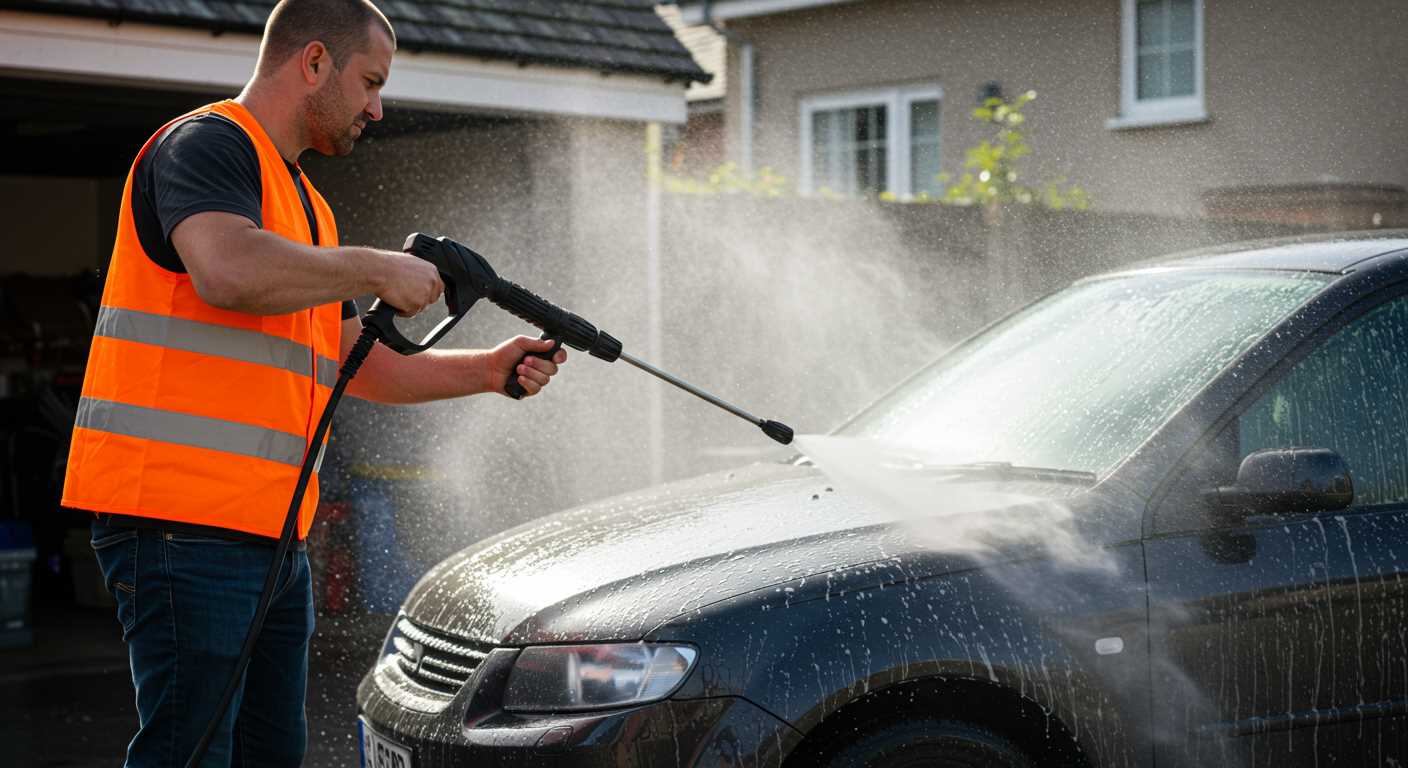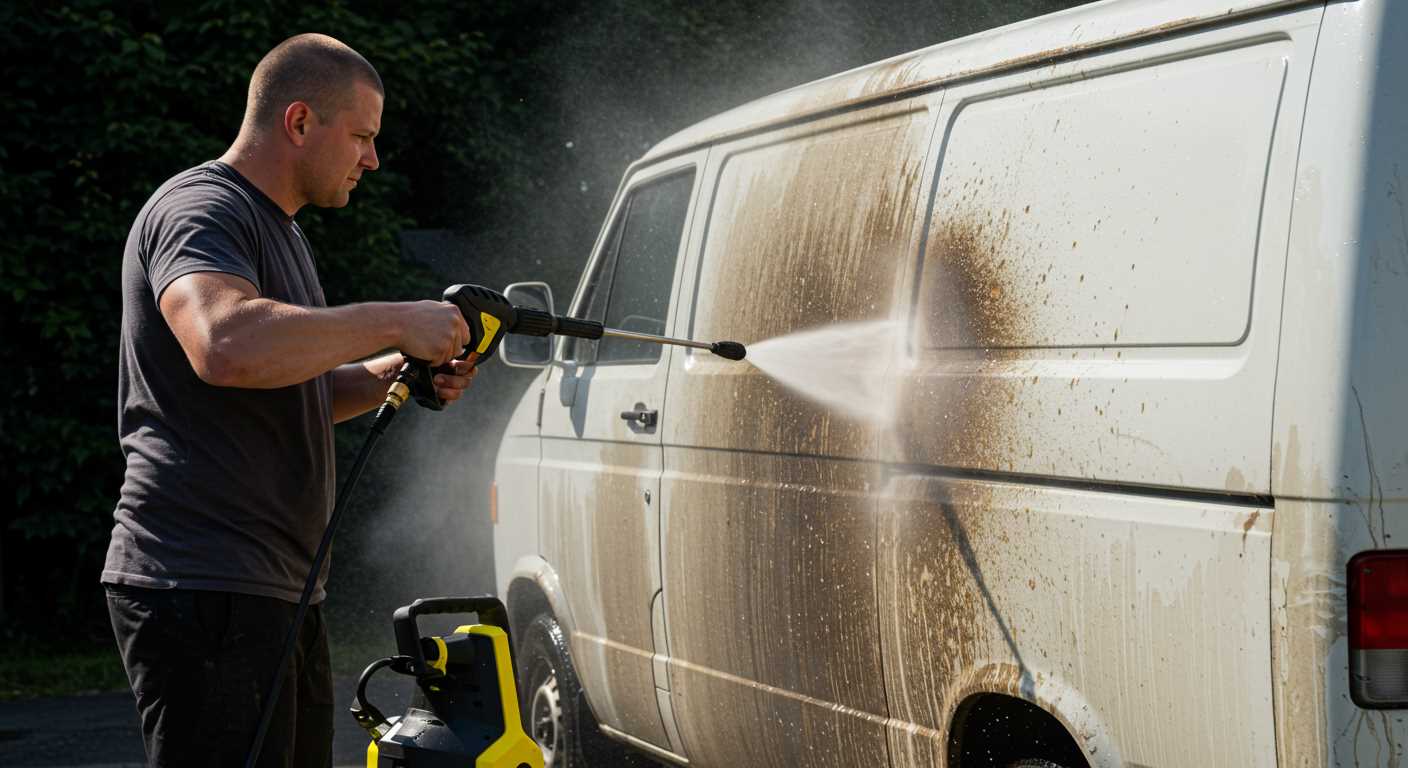



Stucco is a popular choice for the exterior finish of many homes and buildings due to its textured look that adds to the overall appeal of the structure. However, as time goes by, stucco can collect dirt, grime, and stains, which can detract from its appearance. In order to maintain the original beauty of your stucco, it is crucial to regularly clean and upkeep it. One efficient cleaning method for stucco is utilizing a pressure washer.
A pressure washer is a powerful tool that utilizes high-pressure water to eliminate dirt, mildew, and other debris from surfaces. When dealing with stucco, employing a pressure washer can prove to be an efficient and effective means of eradicating accumulated dirt and stains. Nonetheless, it is crucial to employ the appropriate methods and safety measures to prevent stucco damage and ensure a thorough cleansing.
Before employing a pressure washer on stucco, it is imperative to prepare both the surface and the surrounding vicinity. Safeguard any fragile plants or objects in close proximity to shield them from the forceful water. Furthermore, assess the stucco for any cracks or areas in need of repair prior to cleaning. Once the necessary groundwork is completed, the cleaning process can commence.
For optimal results, it is suggested to start with the lowest pressure setting when utilizing a pressure washer on stucco, and adjust it as needed. To avoid causing harm to the stucco, it is advised to employ a wide-angle nozzle that will disperse the water evenly, preventing concentrated streams. It is also crucial to keep a safe distance of approximately 12-24 inches from the surface to prevent any etching or gouging. To ensure a comprehensive and uniform clean, it is recommended to move the pressure washer in a sweeping motion, starting from the top and working downwards.
Understanding Stucco
Stucco is a popular choice for exterior finishes due to its durability and aesthetic appeal. It is commonly used on residential and commercial buildings to provide both protection and decoration. Stucco consists of a mixture of cement, sand, and water, which is applied in layers to create a strong and smooth surface.
The Advantages of Stucco
- One of the main benefits of stucco is its ability to withstand various weather conditions. It is resistant to cracks, fading, and decay, making it an excellent option for areas with extreme temperatures or high levels of humidity.
- Stucco offers an additional layer of protection to a building by being fire-resistant, making it a popular choice for areas at risk of wildfires or with strict fire safety regulations.
- Moreover, stucco is a low-maintenance material that requires minimal upkeep. It does not need frequent repainting and can be easily cleaned with a pressure washer.
- Furthermore, stucco allows for high customization in terms of color and texture. It can be finished with different coatings like acrylic or elastomeric to achieve various looks and provide added flexibility.
Proper Maintenance for Stucco
While stucco is a durable material, regular maintenance is necessary to keep it in good condition. This involves cleaning the surface and inspecting it for any signs of damage or wear.
Utilizing a pressure washer is a powerful method for eliminating grime, mold, and blemishes from stucco surfaces. Nevertheless, it is imperative to employ the correct approach and tools to avoid any harm to the stucco. This incorporates using a low-pressure setting, employing a wide-angle nozzle, and keeping a safe distance from the surface.
Consistent cleaning and maintenance will aid in extending the stucco’s lifespan and guarantee that it remains to enhance a property’s appearance and value for an extended period.
Importance of Regular Cleaning
Maintaining the appearance and durability of stucco surfaces requires regular cleaning. Over time, the surface can accumulate dirt, dust, and other environmental pollutants, which can make it appear dull and unattractive. Cleaning on a regular basis is necessary to remove these particles and restore the stucco’s original brightness and vibrant color.
Regular cleaning is not only important for aesthetics but also for preserving the stucco’s structural integrity. Exposure to the elements can cause cracks and small openings in the stucco, allowing moisture to seep in. If left untreated, this moisture can lead to the growth of mold, mildew, and other water-related damage. By cleaning regularly, any potential issues can be identified and repaired promptly, preventing further damage and prolonging the lifespan of the stucco.
Moreover, consistent maintenance plays a crucial role in promoting a pristine living environment. Stucco facades have the tendency to accumulate irritants such as pollen, dust mites, and mold spores. These irritants have the potential to trigger respiratory issues and allergies in sensitive individuals. By engaging in regular stucco cleaning practices, these irritants are effectively eradicated, resulting in a more sanitary and healthier dwelling space.
Additionally, regular cleaning efforts targeted towards stucco surfaces can significantly contribute to a heightened property value. A well-preserved exterior, including spotless stucco, possesses the capability to substantially enhance the property’s curb appeal. This can prove particularly advantageous when endeavoring to sell a property or attract potential tenants. A pristine and well-maintained stucco facade has the power to create a favorable initial impression, ultimately increasing the perceived worth of the property.
Choosing the Right Pressure Washer
If you are looking to clean stucco, a pressure washer can be quite effective. However, it is essential to select the right pressure washer for the job. The perfect pressure washer will have the ideal power level to eradicate dirt and grime without causing harm to the stucco surface.
There are a few factors to consider when choosing a pressure washer, starting with the pressure rating. The pressure rating, which is measured in pounds per square inch (PSI), indicates the cleaning potency of the machine. Typically, for stucco cleaning, a pressure washer with a PSI rating ranging from 1500 to 3000 should meet your needs. Anything lower than that might not be powerful enough to eliminate stubborn stains, while anything higher runs the risk of damaging the stucco surface.
Another crucial aspect to take into account is the flow capacity of the pressure washer. The flow capacity, which is measured in gallons per minute (GPM), determines how quickly the machine can clean the stucco surface. A higher flow capacity enables faster cleaning, but it may result in more water usage. It is crucial to strike a balance between efficiency and conservation when selecting a pressure washer.
Aside from pressure and flow capacity, it is also worth considering the size and weight of the pressure washer. A smaller, lighter pressure washer can offer easier maneuverability and transportation, thus making it more convenient for cleaning stucco surfaces. However, it is important to ensure that the pressure washer still possesses sufficient power to effectively clean the stucco.
When it comes to selecting the perfect pressure washer for the purpose of cleansing stucco, one must take into account various elements including the pressure rating, flow rate, dimensions, and weight. Opting for a pressure washer that is tailored to the task at hand guarantees efficient cleansing while preventing any potential harm to the stucco surface.
Preparing the Surface for Cleaning
Prior to initiating the cleaning process of your stucco using a pressure washer, it is crucial to adequately ready the surface to guarantee efficient and safe cleaning. By undertaking these measures, you can reduce the risk of potential harm to the stucco and enhance the efficiency of the cleaning procedure.
1. Inspect the Stucco
Begin by conducting a thorough examination of the stucco façade to identify any signs of cracks, chips, or other forms of impairment. Prioritize the repair of any areas that require attention before embarking on the cleaning process. This precautionary measure will serve to mitigate the risk of exacerbating the damage during the cleaning procedure.
2. Remove Loose Debris
Eliminate all loose dirt, dust, or debris from the stucco surface completely by utilizing either a broom or a brush with soft bristles. Take special care in regions with significant accumulations of dirt or debris, as they can impede the cleaning procedure.
3. Shield Adjacent Areas
Prior to commencing the utilization of a pressure washer, it is important to safeguard any surrounding areas that could be adversely affected by water or debris. Cover nearby plants, furniture, windows, and doors with plastic sheets or tarps to prevent any potential damage.
4. Test in an Inconspicuous Area
Before pressure washing the entire stucco surface, it is recommended to test the pressure washer on a small, inconspicuous area to assess its impact on the stucco. Adjust the pressure and distance accordingly to avoid any damage to the stucco.
5. Saturate the Surface
Prior to commencing the cleaning process, thoroughly dampen the stucco surface with water using a standard garden hose. This will help prevent rapid drying of the pressure washer detergent and allow for better penetration of the cleaning solution into the surface.
6. Apply Detergent
If needed, you can use a detergent that is suitable for stucco surfaces to clean the stucco. Make sure you spray the detergent evenly over the stucco with a low-pressure spray nozzle or gently brush it with a soft-bristled brush. Let the detergent sit on the surface for a few minutes so it can effectively lift and remove any tough dirt or stains.
Using the Pressure Washer Safely
1. Familiarize Yourself with the Instruction Manual:
Prior to utilizing a pressure washer for the purpose of cleaning stucco, it is imperative to thoroughly acquaint yourself with and comprehend the instruction manual furnished by the manufacturer. This will guarantee that you are utilizing the equipment in a correct and secure manner.
2. Wear Protective Gear:
It is crucial to ensure your safety when using a pressure washer by wearing the appropriate protective equipment. This includes wearing safety goggles to shield your eyes from debris and water, gloves to protect your hands, and sturdy footwear to safeguard your feet.
3. Keep a Safe Distance:
When utilizing a pressure washer, it is vital to maintain a safe distance from the surface being cleaned. This is important in order to prevent any harm to the stucco and ensure your personal safety. Remember to start with a cautious distance and gradually reduce it as necessary.
4. Start with Low Pressure:
Before you start applying full pressure, it is recommended to begin with a lower pressure setting and gradually increase it in order to avoid causing any harm to the stucco surface. This approach will also help minimize the risk of accidental injury or damage to any nearby objects.
5. Opt for the Appropriate Nozzle:
Choosing the right nozzle for your pressure washer is essential for the effective and safe cleaning of stucco surfaces. It is advisable to use a wide-angle nozzle or a fan nozzle, as they provide a broader spray pattern that is less likely to cause any damage to the stucco.
6. Avoid Direct Spraying at Joints:
It is crucial to refrain from directly spraying joints or areas with loose or damaged stucco when utilizing a pressure washer. Doing so can result in additional harm and result in expensive repairs. Instead, direct the spray at an angle to avoid exerting unnecessary force on these vulnerable spots.
7. Stay Alert and Be Cautious:
When using the pressure washer, it is essential to maintain alertness, attentiveness, and caution. It is important to be aware of your surroundings, particularly if there are individuals or objects in close proximity. Take regular breaks if necessary, and never leave the pressure washer unattended.
By adhering to these safety recommendations, you can confidently and effectively utilize a pressure washer to clean stucco surfaces while minimizing the risk of causing harm or injury. Remember, safety should always be your top priority when operating any type of power equipment.
Cleaning Techniques for Stucco Surfaces
1. Routine Maintenance
In order to maintain the optimal appearance of stucco surfaces, it is essential to engage in routine cleaning. Utilizing a gentle-bristle brush or broom, remove any loose dirt or debris from the surface. This will help prevent the buildup of dirt and grime, simplifying the cleaning process in the future.
2. Mild Detergent Solution
To perform a gentle cleaning, combine a mild detergent solution with warm water. Administer the solution onto the stucco surface utilizing a gentle cloth or sponge. Delicately scrub the surface in a circular pattern, focusing particularly on any discolored or soiled regions. Rinse the surface completely with fresh water to eliminate any remaining residue.
3. Pressure Washing
If you find that the stucco surface is heavily stained or has accumulated stubborn dirt, you have the option of using a pressure washer to clean it. However, it is important to exercise caution in order to prevent any damage to the stucco. Start by setting the pressure washer to a low setting, and make sure to keep the nozzle at least 1 foot away from the surface. In order to effectively remove dirt and stains, move the nozzle in a sweeping motion. Be careful to avoid spraying directly at joints or edges, as this could lead to water seeping behind the stucco and causing damage.
4. Stain Removal
If you notice any discoloration on the stucco surface, especially caused by mold or mildew, you can easily get rid of it with a simple mixture of bleach and water. Simply apply the mixture onto the affected area and carefully scrub it with a soft brush. Let the bleach solution sit for a few minutes, and then rinse it off using clean water. Remember to wear protective gloves and eyewear while working with bleach to ensure your safety.
5. Preventative Measures
To ensure the pristine appearance of stucco surfaces, there are several proactive measures that can be implemented. Firstly, it is important to meticulously trim any surrounding vegetation to prevent unwanted contact with the stucco. Plant residue and moisture can cause unsightly stains and damage. Furthermore, it is advisable to consider applying a transparent coat or sealant to the stucco surface, providing an additional layer of defense against dirt, stains, and moisture.
In summary, regular cleaning and the utilization of appropriate methods are crucial for the upkeep of stucco surfaces. By adhering to these cleaning techniques, homeowners can preserve the attractiveness and longevity of their stucco exteriors.
Post-Cleaning Maintenance Tips
Once you have finished using a pressure washer to clean your stucco, it is vital to follow some maintenance advice in order to preserve its durability and appearance.
Examine the Stucco
After you have completed the cleaning procedure, thoroughly examine the stucco surface for any indications of damage or sections that may need to be repaired. Take note of any cracks, chips, or spots where the stucco may have become loose. Taking care of these problems promptly will prevent further harm and ensure the stucco remains structurally sound.
Seal and Protect
If you want to safeguard your stucco surface, you can apply a sealant that will provide protection against dirt and stains in the future. It is crucial to select a top-notch sealer specifically designed for stucco and follow the instructions provided by the manufacturer for its application. Moreover, you may want to think about using a transparent protective coating that will further enhance the stucco’s ability to withstand moisture and UV damage.
Regular Cleaning and Maintenance
Ensuring the longevity of your stucco requires regular cleaning and maintenance. Incorporate it into your maintenance routine to eliminate any loose dirt or debris from the surface using a soft brush or broom. By doing this, you can prevent the accumulation of dirt and grime, which may result in staining or long-term damage.
Every now and then, you may need to perform a more thorough cleaning of the stucco by utilizing a pressure washer. To reduce the likelihood of any etching or gouging, it is essential to adhere to the correct techniques and guidelines for pressure washing stucco. Consider using a lower pressure setting and a wide fan nozzle.
Monitor and Repair
It is essential to regularly inspect the state of your stucco, particularly in regions that are susceptible to moisture or harsh weather conditions. If you detect any indications of harm, like cracks or loose stucco, it is crucial to promptly address these problems in order to prevent additional deterioration. If you are uncertain about the most appropriate approach, it is advisable to seek guidance from a professional.
By adhering to these guidelines for post-cleaning maintenance, you can guarantee that your stucco endures in good condition and continues to enhance the visual appeal of your residence for years to come.
FAQ
What is the definition of stucco?
Stucco is a substance used to cover exterior walls and surfaces. It is created by combining cement, sand, and water, and can be either textured or smooth.
Why should stucco be cleaned?
Over time, stucco can collect dirt, algae, mold, and various other debris, leading to a dirty and unsightly appearance. Cleaning stucco not only enhances the visual appeal of your home or building, but also prolongs the lifespan of the stucco itself.
Can I clean stucco with a pressure washer?
Indeed, a pressure washer proves to be a highly efficient instrument for cleansing stucco surfaces. It successfully eliminates grime and unwanted elements, revitalizing the stucco and giving it back its initial allure. Yet, it is of utmost importance to exercise caution and ensure proper handling of the pressure washer in order to prevent any harm to the stucco material.
What pressure setting should I use on my pressure washer to clean stucco?
When it comes to cleaning stucco, experts suggest utilizing a pressure setting within the range of 1500-2000 PSI. This level of pressure is sufficient to thoroughly cleanse the stucco while keeping it unharmed. It is crucial to commence with a lower pressure level and gradually boost it if necessary.
Should I use any cleaning solutions when cleaning stucco with a pressure washer?
Indeed, employing a gentle cleaning agent or a specifically designed stucco cleanser can enhance the effectiveness of eliminating dirt and blemishes from the stucco surface. It is imperative to adhere to the directives on the cleaning solution and ensure adequate rinsing of the stucco subsequent to cleaning.
Are there any precautions I should take when cleaning stucco with a pressure washer?
It is important to take certain precautions when using a pressure washer to clean stucco. To begin with, it is crucial to safeguard any nearby plants or delicate objects by covering them up, as the force of the high-pressure water can cause damage. Furthermore, it is important to refrain from using the pressure washer on any areas of the stucco that are loose or already damaged, as this can exacerbate the existing problems. Lastly, it is imperative to wear protective eyewear and follow proper safety protocols when operating a pressure washer.

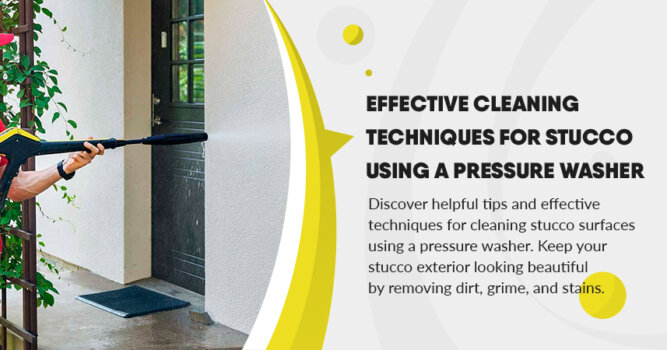


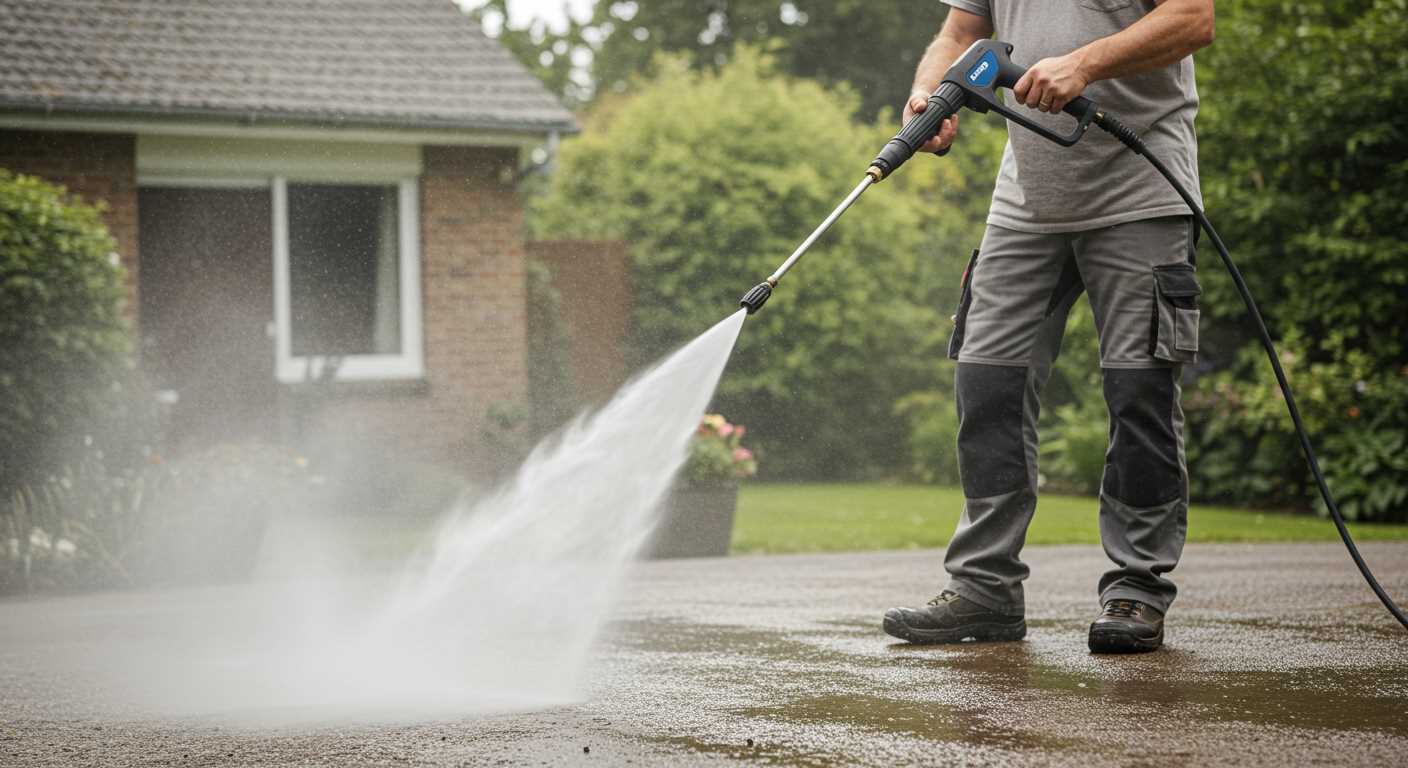
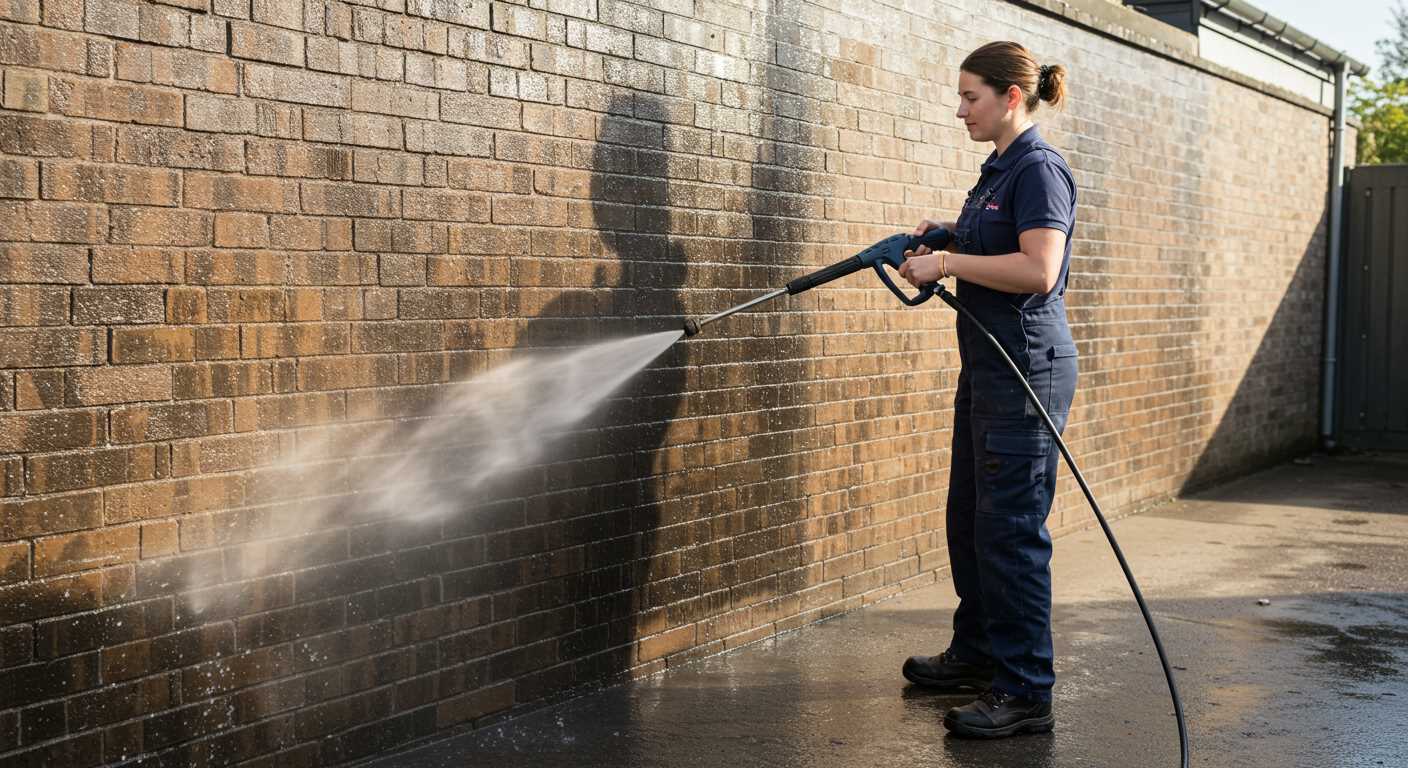
.jpg)
